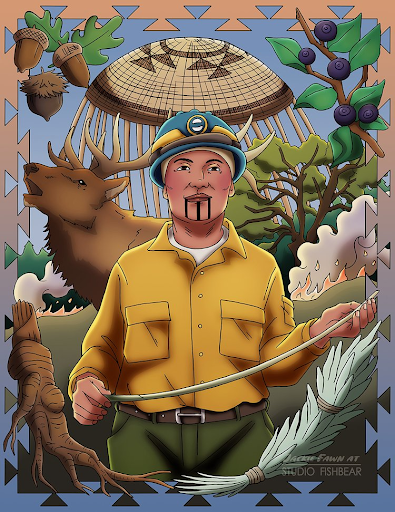Overview
Forest and Fires

- Author: Star Gibbens (Yurok)
- Lesson Contributor/Editor/Format by Maggie Peters (Yurok/Karuk), NASMC Learning Specialists Humboldt County Office of Education
Grade: 4
Suggested Amount of Time: 90-100 minutes or two 45 minute sessions
Curriculum Themes
- History
- Cultural Strengths
- Relationship to Place
- Cross Curricular Integration
Learning Goals
- Examine forests and threats to the forests.
- Classify aspects of fire and Fire Science, including controlled fire, cultural fire and prescribed burning.
- Describe Traditional Ecological Knowledge and cultural significant practices of Indigenous people
Lesson Overview
This cross curricular lesson introduces students to the differences between wildfires and cultural or controlled fires, grounding their learning in both traditional ecological knowledge and scientific understanding. Designed for 4th grade learners, the lesson uses clear language and high-interest visuals to explain how Indigenous fire practitioners have used fire as a powerful tool to care for their ancestral territory and ecosystems for generations. Through a combination of student-friendly slide presentations, videos from Native fire experts, a vocabulary-rich reader, and real-world examples, students will explore how cultural fire supports biodiversity, restores landscapes, and protects communities from dangerous wildfires.
The lesson offers multiple opportunities for student engagement and collaboration, including think-pair-share discussions, a fill-in-the-blank comprehension handout, and vocabulary activities such as a word search and crossword puzzle. Visual learners will benefit from rich photo slides and video content, readers will enjoy the culturally sustaining student reader that highlights key concepts like "controlled burn," "stewards of the land," and "invasive plants." Best of all, this lesson uplifts Indigenous knowledge systems alongside scientific inquiry, helping students understand how long-practiced cultural fire methods are effective and essential in today’s changing climate. This is an ideal lesson for building environmental awareness, critical thinking, and cultural respect in your classroom.
Teacher Background
When teaching about fire, especially in California, where many students have experienced the effects of catastrophic wildfires, it’s important to approach the topic with both care and sensitivity. This lesson highlights the difference between harmful wildfires and cultural or controlled burns, a practice that has long been part of Indigenous land stewardship. While the content celebrates fire as a positive ecological tool, it’s crucial to recognize that fire can also be deeply emotional and traumatic for students who have lost homes, been displaced, or lived through evacuation events. Begin by creating a safe classroom space where students can choose whether or not to share personal experiences. Acknowledge that fire can feel scary or overwhelming, but also frame the lesson around resilience, both ecological and cultural.
Highlight that cultural fire practices are guided by deep observation, science, and respect for the land, and that these methods are used to prevent destructive wildfires, support biodiversity, and restore balance to ecosystems. Emphasize the wisdom and leadership of Indigenous fire practitioners, who are offering real solutions in the face of a changing climate. Throughout the lesson, keep the tone respectful and hopeful, and allow students to process at their own pace. Use visuals and collaborative discussions to make the content approachable and empowering, and be mindful of student responses as you move through potentially sensitive material.

